Why did the French stick to single towers?
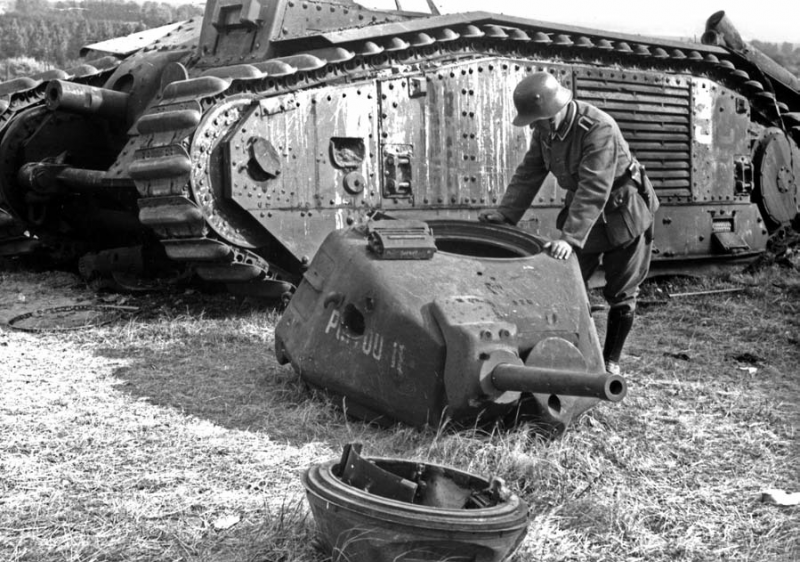
French Tanks The 30s are notorious for their single turrets. If in other countries such turrets were installed only on the lightest and most compact vehicles, then in France they can be found even in the project of a 45-ton tank. It hardly needs proof that this is a very bad decision. During the battles of 1940, the Germans noted that French tanks were slow to respond. Overburdened commanders could not as effectively detect the enemy, monitor the battle and give orders. This reduced efficiency and controllability.
In this article we will try to figure out why the French stuck to single towers for so long. Note that it is impossible to give a simple answer to this question by indicating only one reason. We'll talk about mounting the main weapons in the hull, touch on types of radio communications, and also look at how the French and Germans approached the same problems differently.
Brushing aside some myths
Single turrets, like other problems with French tanks, are often explained by the backwardness of military thought. They say that the generals were preparing for a repeat of the last war and ordered the engineers the good old Renault FT in a new version. One can hardly agree with this view. The French were the first to launch a tank with a turret, created heavy tanks with three-man turrets, and implemented precise gun guidance by rotating the hull. They came up with swinging towers, experimented with strobe lights, and were the first to think about installing a rangefinder on a tank. Taking into account these achievements, it is rather reckless to talk about backwardness.
The influence of the Renault FT should not be overestimated. The success of this tank was determined not by its technical characteristics, which were rather modest, but by its mass and cheap production. The French infantry initially ordered the D1 light tank with three crew members and a 47 mm gun. However, it turned out to be too heavy and expensive, and also extremely structurally unsuccessful. Therefore, instead it was necessary to purchase R 35 and H 35 tanks with a very weak 37 mm cannon and two crew members. The French cavalry lacked powerful S 35 tanks, so its tank divisions received mediocre H 35s. In general, this was not story admiration for the success of Renault FT, and a banal shortage of tanks on the eve of a new world war. Actually, even during the great war, the “father of tanks” General Etienne would have preferred to have more vehicles with 75 mm guns instead of the Renault FT.
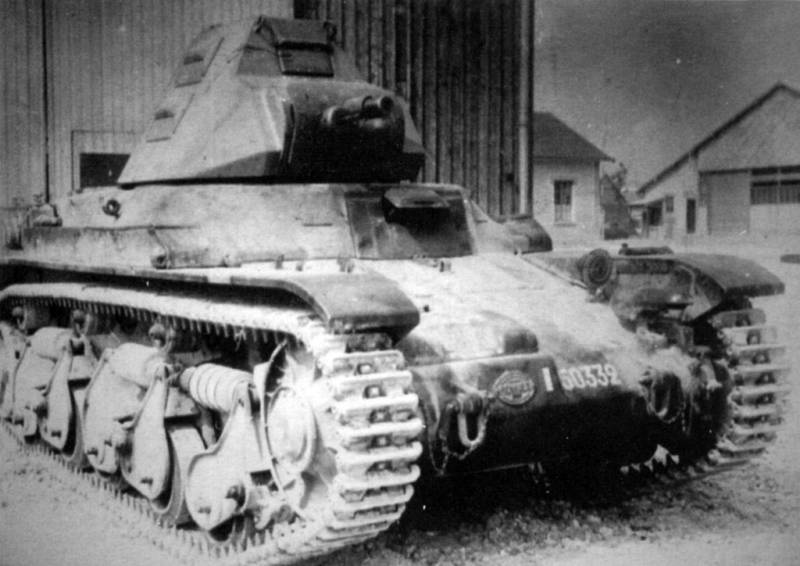
An example of a “head transplant” is the R 35 with a welded turret FCM 36. The turrets of these tanks were interchangeable
Recently, another myth has appeared: supposedly the French installed single-man turrets on most tanks due to unification. Indeed, many French tanks have the same shoulder straps, so their turrets can be swapped. There is nothing strange about this. There were cases when the turret was replaced with a more successful one, or an improved chassis was created for the existing turret. In addition, the French often developed turrets and tank chassis independently by different companies.
This practice was not unique. In Germany, the development of turrets and tank chassis was also often carried out by different companies. The Germans unified shoulder straps and engaged in “head transplants”, but came to different results. This means that the point is not in the unification itself.
The appearance of the radio operator
In the 20-30s, the French took tank protection perhaps more seriously than anyone else. Therefore, they tried to reduce the armor volume and make do with a minimum crew, because otherwise the weight of the tanks would become too large. In these conditions, it is extremely important how the crew members combine their responsibilities.
At first, the successor to the Renault FT was thought of as a two-seater tank, but the installation of a radio station required the introduction of a third crew member. In those years, the infantry used Morse code, the radio operator typed messages with a key and could not effectively help the turret. On D1 it was placed in the hull, but the turret remained single-seat. Similarly, on tanks D2 and B1, the commander worked alone in the turret, and the radio operator sat in the hull. The French themselves called him a radiotelegraphist (radiotélégraphiste). Let us emphasize once again: the radio stations ER52 and ER53 of infantry tanks could not transmit voice in principle. This drawback was eliminated in the ER51 radio of the 1938 model, when the appearance of the tanks had already taken shape.
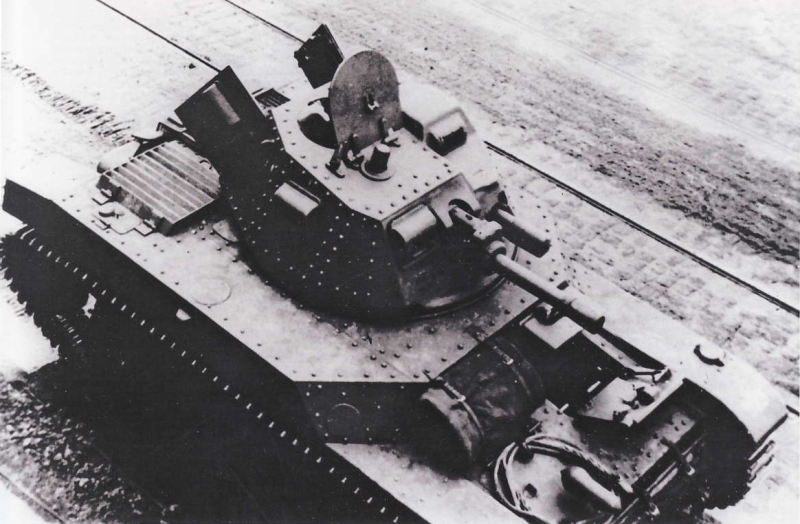
Cavalry tank AMC 35 with a two-man turret and a 47 mm cannon. She had hatches on the roof and rear sheet
Unlike the infantry, the cavalry chose voice radio communications, which is why two-man turrets appeared on the AMC 34 and AMC 35 tanks. Of course, many tanks did not receive radio stations at all. The French were doing poorly with them, both in terms of quantity and quality. However, the possibility of radio communication was provided, and then one of the towers became a radio operator.
Stay in the 20-ton class
Generally, the French cavalry's approach to the towers was more intelligent than that of the infantry. The turrets of cavalry tanks and armored vehicles were equipped with hatches on the roof, with the help of which it was convenient to leave the vehicle or conduct observation outside of combat. But the turrets of infantry tanks were equipped with blind observation turrets and seat hatches in the sides. The French tankers didn't like them. The Germans often sawed off the roofs of the turrets on captured tanks, welding double-leaf hatches.
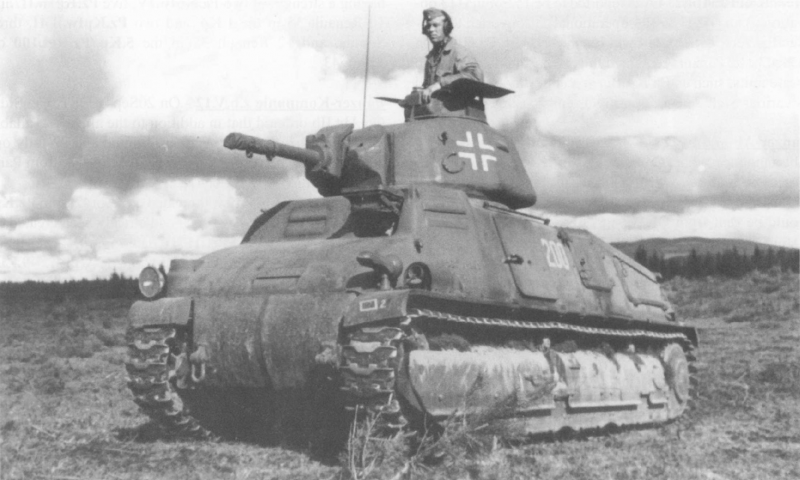
Captured S 35 in German service. The Germans installed their own radio stations and sawed off the blind turrets, welding double-leaf hatches
The AMC 35 cavalry tank received a two-man APX 2 turret with a good 47 mm gun, a 1395 mm shoulder strap, an electric drive and a roof hatch. However, it could not become the main tank of the French cavalry. Firstly, its chassis was constantly breaking down. In those years, Renault made its tanks cheaper by hook or by crook, so their reliability was poor. The AMC 35 was no exception. Secondly, the military demanded that the armor thickness be increased to 40 mm. This led to the creation of the larger SOMUA S 35 heavy tank.
The chassis of the S 35 tank turned out to be very modern and, most importantly, reliable. However, its APX 1 turret was originally the same as that of the B1 and D2 infantry tanks. She had no sunroof, and the commander became a one-man band. Why did this happen? The radio operator was again sitting in the building, because on the command vehicles he worked with two radio stations. The two-seat turret required a crew of four, but the engineers hit the 20-ton limit—the weight of the S 35 was 19,5 tons. The single-man turret helped lighten the tank, meeting the requirements. Judge for yourself: the AMC 35 turret weighed 2 tons with 25 mm armor, and the S 35 turret weighed the same 2 tons, but with 40 mm armor.
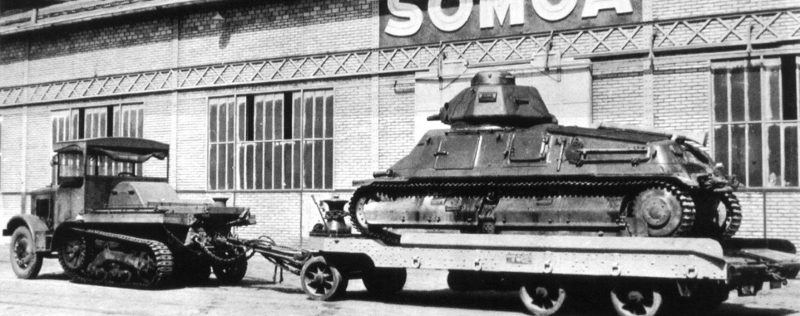
S 35 prototype with APX 1 turret on a 20-ton platform. In this form, tanks were transported over long distances.
The 20-ton limit did not appear by chance. The military assumed that a tank weighing up to 20 tons could withstand 90% of bridges, and only 20% of bridges weighing more than 50 tons. In the first case, the tank is much easier to transport across constructed bridges and transport on platforms. In 1935, the French had about 200 tractors with platforms that could transport tanks weighing more than 20 tons, and a thousand platforms for lighter tanks. These considerations forced a compromise. The crew of the S 35 was limited to three tankers, but the turret ring was expanded from 1022 mm to 1130 mm so that the radio operator could help the commander with reloading. The converted turret was called APX 1 CE (chemin élargi - increased shoulder straps), sometimes it is called a “one and a half man” turret.
Failed compromises
Like the French, the Germans tried to keep the weight of mass-produced tanks at 18-20 tons. The reasons were similar: crossing bridges, the carrying capacity of platforms and the possibility of evacuation with heavy half-track tractors. However, they spent the same limit differently. The French D2 and S 35 weighed 19,8 and 19,5 tons, the German Pz.Kpfw.III Ausf.E and Pz.Kpfw.IV Ausf.B - 19,5 and 18,5 tons, respectively. The French are distinguished by powerful 40 mm armor and a crew of three. The Germans have a crew of five people, but the 37 mm gun is weaker than the French 47 mm caliber, and the armor thickness does not exceed 30 mm in the forehead and 20 mm in the sides (for the Pz.Kpfw.IV it is 14,5 mm).
Both compromises failed. German tanks were too poorly protected. Their armor was easily damaged even by a light 25mm Hotchkiss anti-tank gun, which can be hidden behind any bush. French tanks were poorly controlled and their commanders were overburdened with responsibilities. But after the battles, the Germans drew conclusions, strengthened the frontal armor to 50-60 mm and installed a 50 mm cannon on the PzIII. But the French were defeated; they had practically no opportunity to develop their tanks under German occupation.
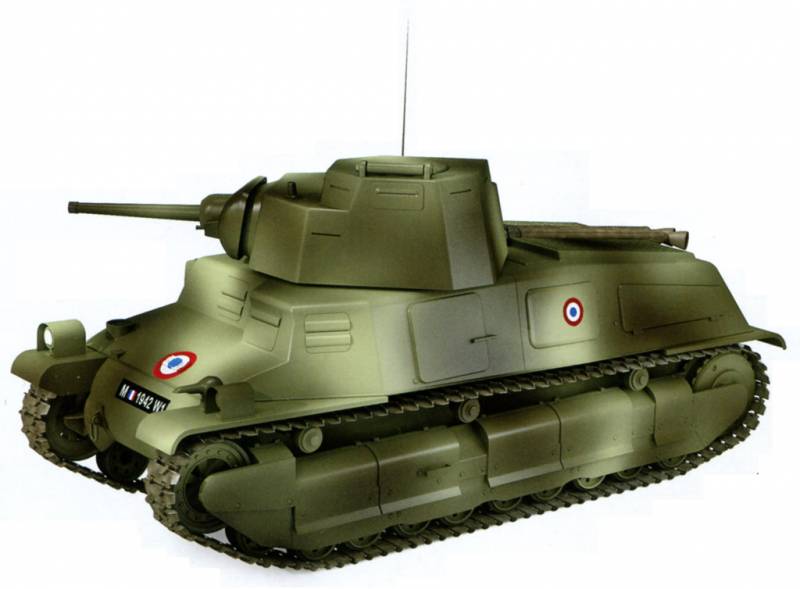
This is what a SOMUA might look like with a three-man turret and an SA37 cannon. The S 40 chassis differs from the older S 35 with raised idlers, a more powerful engine and reinforced armor.
Technically, the S 35 chassis made it possible to install a turret with 2-3 crew members. What this could look like is shown by the projects of the FCM company, which found itself outside the occupation zone. In 1942, its engineers secretly developed a two-seat welded turret for the S 35 with a 1435 mm shoulder strap. She received a polygon, as well as a commander's cupola with a hatch and a retractable anti-aircraft machine gun. Next, FCM prepared drawings of a three-man turret with the same shoulder strap and a more powerful 47-mm SA 37 cannon. By the time of the liberation of France, the S 35 was hopelessly outdated, so the projects remained on paper.
Battle check
While we were discussing technical details, such as the specifics of radio communications or weight restrictions. But there was another reason for the passion for single towers - the French simply did not understand how bad a compromise this was! Here are the memories of Lieutenant Jean Baillou, who served on the S 35, and later on the Sherman. According to him, before the war, French tank crews were worried about the low reliability of radio stations. They constantly broke down, so during exercises the Hotchkiss and SOMUA tanks had to be driven with flags. But the tankers didn’t care about the single-seat turrets. It was only after the first battles that they realized how bad an idea this was.
Bayu gave an example of a battle that took place on May 13, 1940 in Belgium. His tank was crossing the village and unexpectedly collided with a German Pz.Kpfw.II, which was facing in the other direction. He fired a confident shot from 50 meters, breaking through the tower and killing the commander. The German began to retreat in reverse. The Bayou tank went into battle without a radio operator, so there was no one to help with reloading. Bayou looked up from his sight, loaded his gun and saw the edge of a German tank. The second shot finished off the German tank.

Interior of the APX 1 CE turret of the S 35 tank. Although the shoulder straps became larger, there was clearly not enough space for two people. The radio operator-loader had to dodge falling cartridges
This incident made a great impression on Bayou. It was dark in the tank, so when he looked up from the observation devices, his eyes could not immediately adjust to the darkness, and vice versa. Because of this, finding the necessary ammunition was difficult, and the seconds were counting. Bayou kept several 47mm rounds in his pockets from then on. After the war, he studied detailed Belgian chronicles and was surprised to discover that two Pz.Kpfw.IIs were destroyed at that site. It turns out that he knocked out the first tank and did not notice that it had retreated and a second one was visible in its place. This once again proves the importance of continuous observation in combat.
General Etienne's legacy
The French concept of single-man turrets was based on the assumption that it would not be too difficult for the commander to load the cannon himself. Jean Bayu was even able to organize the first-stage ammunition rack in his pockets, fortunately, the shots of 25-47 mm calibers were small. But more powerful 47 mm guns required a separate loader, not to mention guns of 75-105 mm caliber.
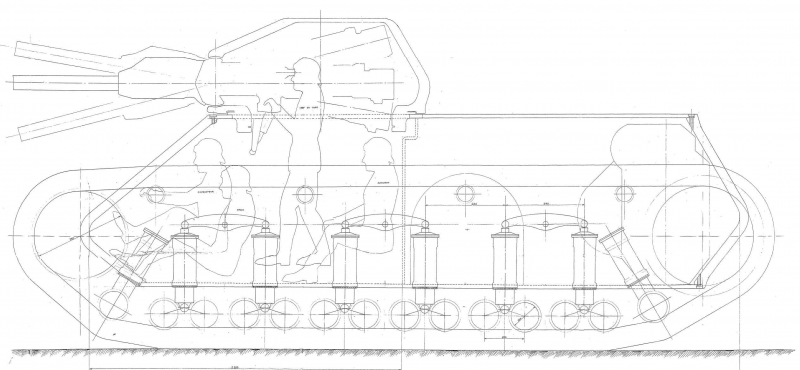
Draft design of the 1939 AMX medium tank. Note the shape of the hull and the crew of four, two of whom worked in the turret
Indeed, French designs for super-heavy tanks included three-man main turrets. At a late stage of development, G1 medium tanks also received two- or three-man turrets with a 75 mm gun. Here the French did not constrain themselves with a minimum price or a 20-ton limit. The preliminary design of the AMX medium tank with thick sloping armor and a powerful 47 mm SA37 cannon is indicative. It was impossible to push it into 20 tons, so they didn’t save money and planned a normal two-man turret.
The B1 heavy tank with a 75 mm main gun in the hull and a single-man turret, like the D2, deserves special consideration. It grew out of an idea by General Etienne during the First World War. The logic was this. France built the Renault FT light tank en masse, but its 37 mm gun was too weak. The FCM 1A heavy tank with a three-man turret was armed with a 105 mm cannon, but was too large and expensive. The best type was a medium tank with a 75mm cannon that could destroy light fortifications and enemy tanks.
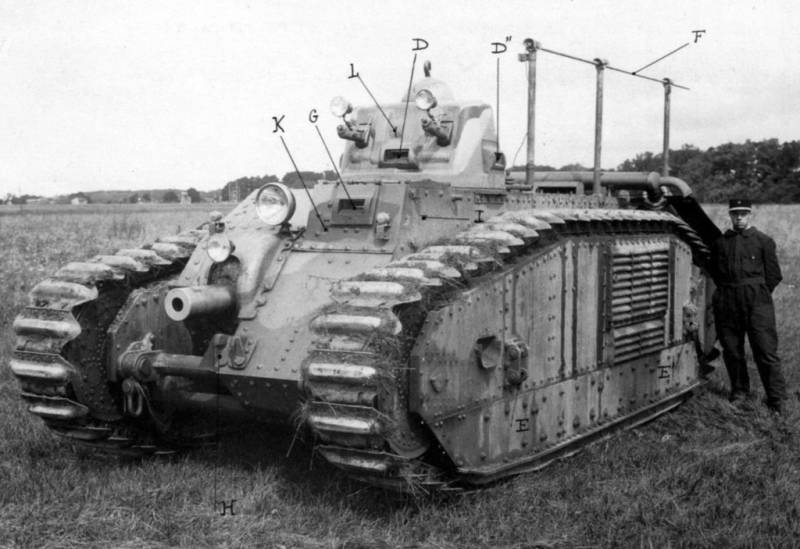
The B1 tank in its original form is essentially a self-propelled gun with a machine-gun turret. The antenna indicates the presence of radio communication
This is how the idea of a tank, essentially an assault gun, with a 75-mm cannon in the hull and a crew of three people arose. The commander sat in the machine-gun turret, conducted observation and scared off enemy infantry. The driver controlled the tank and aimed the gun, and the third tanker was the loader. The gun in the hull was very low in order to hit embrasures at ground level with extreme efficiency. In addition, the tank turned out to be lighter. The installation of a 75-mm gun with armor weighed about a ton. Let us remember that the two-man turret with a 47-mm cannon weighed two tons.
And then the assault tank began to “get fat.” A radio operator was added to the crew, who was located in the hull. The machine gun turret was replaced with a turret with a 47 mm cannon. On production B1s, the armor thickness was increased to 40 mm, and on B1 bis to 60 mm. In total, an assault gun weighing 15-20 tons turned into a heavy two-gun tank weighing 32 tons. And this is not the limit: the experienced B1 ter “gained weight” by another 4 tons. Actually, the 45-ton heavy tank mentioned at the very beginning also repeated the B1 concept, but was even more powerful and heavier. Hence his anecdotal single tower.
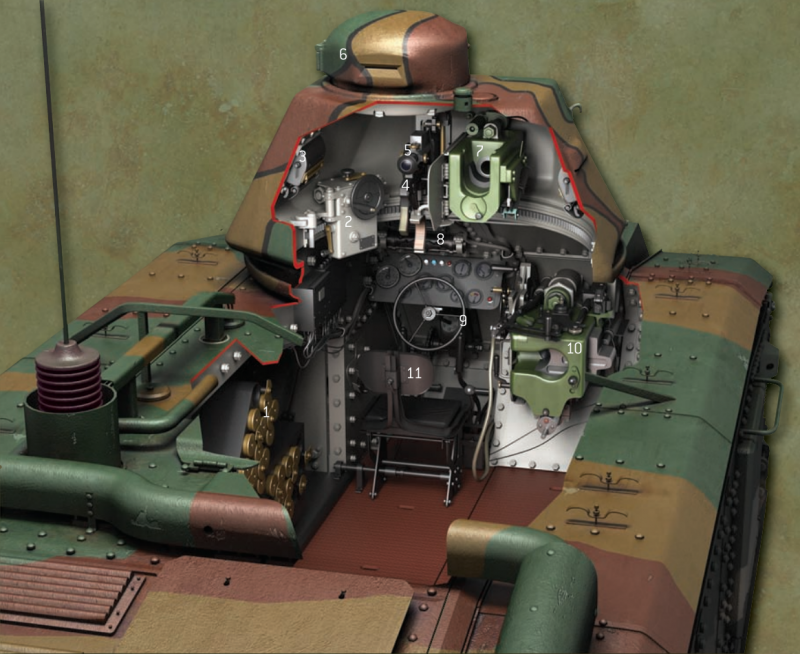
Interior of a production B1 bis with two guns. The radio operator was placed next to the commander
Conclusion
If we put all the facts and reasoning together, we will see the following picture.
1. Light tanks like the R 35 or H 39 inevitably received single-man turrets, because they were designed to be as widespread and cheap as possible. The German Pz.Kpfw.I and Pz.Kpfw.II with single turrets are no better here.
2. On medium tanks D2 and S 35, the crew grew to three people, but the turrets remained single-seat. By making this compromise, the French received adequate armor in the 20-ton class, but worsened handling. They did not understand how critical the division of duties is in battle.
3. The B1 heavy tank was created around a 75 mm cannon in the hull. Its single-man turret was originally just a commander's machine-gun turret. Self-propelled guns SAu 40 and ARL V39 had similar turrets. If we draw analogies, then the B1 was something between the StuG III assault gun and the experimental VK 30.01 (H) tank.
4. Rare tanks and armored vehicles with turrets for 2-3 people, as a rule, were vehicles with weak armor or, conversely, very powerful tanks. The first ones were quite light and easily fit into strict weight limits, while the second ones obviously fell out of them.
The author expresses gratitude to Dmitry Babkin for his assistance in working on the article.
Sources:
Information